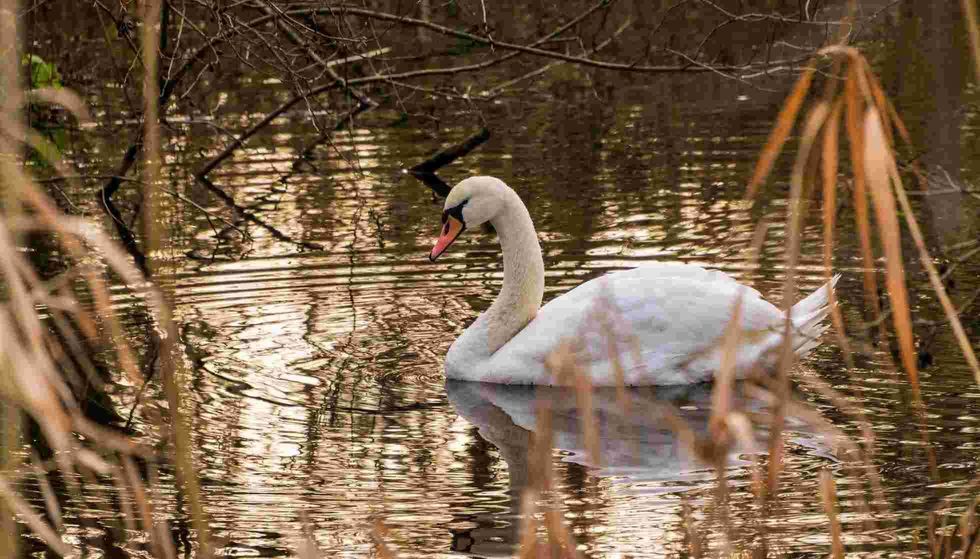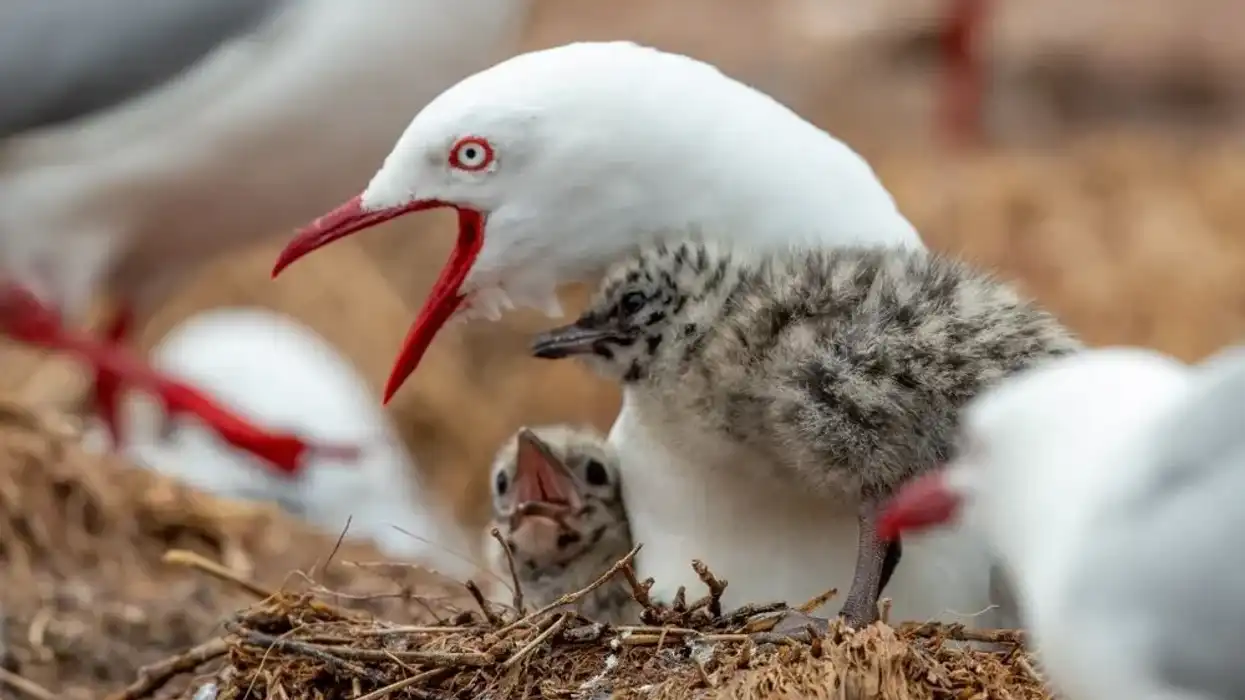Domesticated goose is a generic term given to all the geese found worldwide derived from the selective breeding of the wild geese, namely greylag and the swan. The geese widely interbreed, and did you know swoose is the hybrid of swan and goose?
They are beautiful birds and are migratory. So if you see those large birds flying high up in the sky in a V-shaped formation, then be sure that is a gaggle. And did you know that according to few mountaineers, they have sighted geese flock over the Himalayas?
Humans have entirely tamed the geese for quite some time, dating back to few thousand years. And the domesticated Geese are the result of selective breeding to tame them.
Very friendly, very adaptive, and very loyal are the excellent traits of the behavior of the domesticated geese, which make them famous pets. Also, they are raised in poultry farms for commercial purposes for their eggs, meat, and foie grass. And did you know that a goose is said to lay over fifty eggs per year?
You will enjoy reading this article. Explore our secretary bird facts and duck facts articles to find out more!
Domesticated Geese Interesting Facts
What type of animals are domesticated geese?
The original domestic geese are derived from Greylag goose in Europe, northern Africa, and western Asia. And in eastern Asia, they are from the swan goose. Domestic geese are derived from the breeding of wild greylag and swan geese. The domesticated geese of the swan goose have a different prominent bill knob.
What class of animals do domesticated geese belong to?
In general, domesticated geese may belong to any of the two genera, Anser and Branta. As such, the goose belongs to the Aves class of the Anatidae family. The swan goose (Anser cygnoides) and greylag both belong to the Anser genus.
How many domesticated geese are there in the world?
The data on the exact number of domestic geese in the world is not available. But there are a variety of birds that are found in the world in abundance. But due to habitat loss, their numbers are decreasing.
Where do domesticated geese live?
The birds are found in North America, Australia, Asia, Africa, and Europe. These birds are heavier than wild geese. The geese are kept in poultry hutches or raised in open grasslands in these countries.
What is a domesticated goose's habitat?
Domestic geese are very adaptive and found in a variety of natural habitats, even in the wild. The breeds are a part of the water ecosystem. Living mostly in freshwater, including lakes, ponds, marshes, streams, wetlands, etc.
They can be spotted in public parks, farmlands, pastures, etc. One can see these geese in the urban and semi-urban in open natural grassy areas near water bodies. They are raised in poultry farms as well.
Who do domesticated geese live with?
Domestic goose lives in small to large groups. The breeds are friendly and go along well with other animals on a farm as well. They are kept in large numbers together in poultry.
As in human-inhabited areas, they are also comfortable to hang around. But the birds stick around water to protect themselves from any predators. And as a pair, they are loyal to each other for a lifetime.
How long do domesticated geese live?
These lovely domestic geese live a really long life of almost two decades and sometimes more. And if properly taken care of, a few of the species of domesticated geese are said to live for longer.
How do they reproduce?
Domestic geese reproduce by the sexual reproduction process and are monogamous birds. The pair stick together for their lifetime, which means they mate for life.
They are very protective and territorial of their nests. The birds come back to the same nesting sites every year during the breeding season, typically in the surrounding where they hatched.
They are sexually mature at around two to three years of age. Depending on the size of the bird, females can lay anywhere around five to eight eggs in a clutch.
The females do the incubating of the eggs, and the males stick around on guard. The little ones hatch out in a month's time—the young forage around in a day.
In a matter of two to three months, the goslings grow in weight and are fit to take a flight. Yet, they stick around for a year and come back to their nesting site with their parents.
What is their conservation status?
According to IUCN Red List, the conservation status of domestic geese is of Least Concern. Though they are found in abundance across the globe, few of the species are vulnerable and near threatened due to habitat loss.
The breeds are found in almost all the continents on earth. The waterfowls are one of the oldest domestic breeds but are not exploited for meat and eggs for commercial purposes like the hens or maybe even ducks.
Domesticated Geese Fun Facts
What do domesticated geese look like?

Geese are generally large birds with heavy bodies. A slim head, large bill, and a long neck are its distinguishable features.
They have wide webbed feet and short legs for efficient swimming and walking. The breed has strong wings with long feathers, and the birds come in different colors. The plumage may be white, grey, brown, black, buff, or a combination of them.
How cute are they?
The domestic goose is a cute and friendly bird. These breeds are one of those birds that anyone would like to have around in their farms. All they need is water. The breed is beautiful companions to have around. Either on their own, in pairs, or in a flock, these birds are appealing.
How do they communicate?
Domestic geese communicate by both physical and vocal cues. The breed has a loud voice.
They sound like ascending honk, and as a warning call, they give out a more barking honk in succession to alert others and accompany it with physical gestures like spreading their wings to threaten away the predator. But as such, the domestic geese are not predators themselves.
During courtship, the breeds exhibit their beautiful wings and feathers in a display and make a softer call, and tend to each other with their bills.
How big are domesticated geese?
The domestic goose is typically a medium-large bird with a heavy body and short legs. Swan goose is between 32 to 37 in (81 – 94 cm) in length and 24 to 30 in (60.9-76.2 cm) in height. In general, geese can be larger or smaller than the specified measurements depending on the breed of the species.
How fast can domesticated geese move?
Typically because of their heavy body, flying seems difficult for these birds. However, the domestic goose can fly at speeds of 30 mph (48.3 kph).
The migratory species are said to travel around three thousand miles in a season, even at heights of thousands of meters above sea levels. These breeds flock in V- shape, and birds take turns to lead the flock. The geese can also walk on the ground and swim in water but not at great speeds.
How much do domesticated geese weigh?
The domesticated geese are categorized into light, medium, and heavy birds based on their weight. A swan goose weighs between 6.2 to 7.7 lb (2.8-3.5 kg). But as mentioned earlier, geese weight can be more or lesser than that depending on the breed of the species.
What are the male and female names of the species?
Males of geese are called ganders, and females are known as hens. They exhibit sexual dimorphism, and the male is much larger in size than the female, both in terms of height and weight.
Geese are monogamous, and the males are very possessive and protective about their females. A group of this breed is called a gaggle or a skein, or a flock.
What would you call a baby domesticated goose?
A baby domesticated goose is known as a gosling. Goslings are precocial and leave the nest within a day. However, they are under parental protection and care for two to three months before they gain weight and are fit to fly. But the young ones stick around their parents for about a year.
What do they eat?
Domestic geese primarily eat fish. But typically, they can also enjoy mollusks, moss, seeds, and small insects as well.
The breeds are also fed with skunk cabbage etc., and the birds also forage on eelgrass and other sedges. During winter, geese depend on agricultural grains like corn. The adults teach the young gosling how to grab a fish with the bill and eat it.
Are they poisonous?
No, domesticated goose is not poisonous.
Would they make a good pet?
Geese make excellent pets. This healthy breed is trendy to have around farms and lawns.
Toulouse goose is the best goose for a pet. These birds are entirely adaptive, and friendly nature is the major reason they are loved as pets.
Also, these breeds don't demand much in terms of their personal care except few basics like regular cleaning and good quality feed. But yeah, they are noisy, and with children in the house, it is important to have an eye on them when around them.
The birds generally do not fly away, but if they feel threatened may do so.
For sure, once in, the geese get attached to you very soon. And because of their longevity, the bird sticks for a long time with you.
No extra efforts are required to feed your domesticated geese. If you have a grass lawn, they can be fed with corn, wheat, barley, birdseed, grapes, etc.
Did you know...
Pomeranian name is not only for a dog bed but also for one of the geese breeds.
The research is underway to understand the longitudinal partial migration patterns of Orinoco geese domesticated in Peru.
Take a gander is actually an expression used to ask someone to have a look at something or someone. For example, Take a gander at that new bike. And of course, 'wild goose chase,' 'golden goose' expressions are also famous.
Can you domesticate a goose?
Yes, you can domesticate a goose. In fact, as mentioned earlier, the breed was one of the domesticated species in history some thousands of years ago, and they are bred for various reasons. Open natural spaces are best to have a domesticated goose with a well-ventilated shelter to sleep.
But, one needs to give little time to the goose to adapt to the environment and people around. Domestic geese are also bred and raised in poultry farms for meat and eggs. But wild geese can not be domesticated.
What are the friendliest geese?
Toulouse geese are popular for their friendly nature and adaptability. These are some of the popular breeds that look like greylag geese. They are very calm and quiet. They are completely loyal and stick around, and do not rush.
Here at Kidadl, we have carefully created lots of interesting family-friendly animal facts for everyone to discover! Learn more about some other birds including cackling goose facts and Egyptian goose facts.
You can even occupy yourself at home by coloring in one of our free printable domesticated geese coloring pages.









